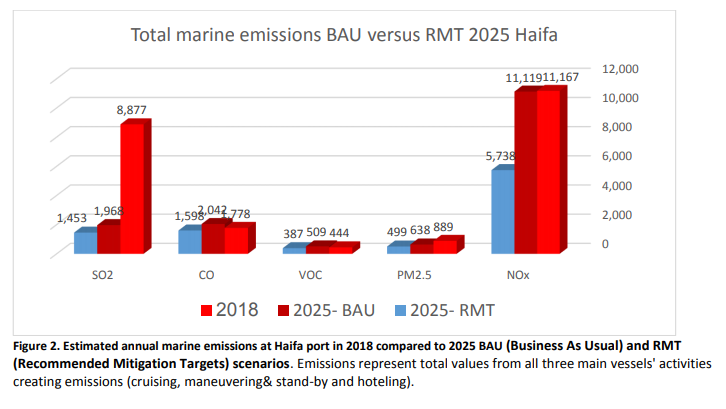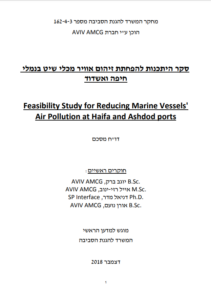A new study on emissions in Israeli ports found that the air pollution created by ships at Haifa and Ashdod ports are extremely high and similar in scope to a large power plant running exclusively on diesel fuel oil. Most of these emissions are emitted during the hoteling stage of the vessel, further to additional high emissions emitted during vessels’ maneuvering and stand by activities within short distances from the port’s land (0.5-5 km).
The study was conducted by AVIV AMCG and financed by the Israeli Ministry of Environmental Protection, as part of 2016 call for research on the environmental pollution at different mediums in the Haifa bay area.
The findings suggest that the total instantaneous emissions during a peak hour can be compared to a 1,000 MW diesel fuel oil power plant emissions in Haifa Port and to a 700 MW diesel fuel oil power plant emissions in Ashdod port.
Accordingly, in 2018, these levels of pollution include at Haifa and Ashdod ports respectively:
- 11,100 and 7,250 ton/year emission of NOx
- 9,000 and 6,250 ton/year emission of SOx
- 1,800 and 1,130 ton/year emission of CO
- 900 and 560 ton/year emission of PM2.5
- 450 and 280 ton/year emission of VOC
The study that tackling the air pollution from the marine sector will be very difficult, due to many reasons, including:
- Every moment at each port there is a need to cope with dozens of different changing emissions’ sources either stationary or in motion (emissions from hoteling, cruising, maneuvering and stand-by). As shown in the report, each of these types of emissions have a significant contribution on the total emissions at the port.
- Large number of vessels being flagged (registered) at other countries, where regulations do not require emission abatement techniques.
- The high cost and technical complexity of installing after treatment techniques (as detailed in the report).
- Insufficient supporting international regulations (excluding new regulations regarding SOx emissions)
Trade-wise, Israel is a relatively small country and therefore maybe limited in its ability to to impose drastic restrictions (by its own) that bigger players can, such as China and various states in the US and the EU.
However, is is concluded that even after the expected future extensions of marine activities at each port, it is possible to implement a combination of steps as part of a long term and gradual mitigation plan that will enable to achieve by 2030 a significant pollution reduction of NOx.
Such a plan can achieve reduction of 50%-70% in NOx emissions at both Haifa and Ashdod ports.
Accordingly, NOx emissions at Haifa port can be reduced to levels of 3,200-5,000 ton/year and at Ashdod port, it can be reduced to levels of 2,000-3,000 ton/year.

Recommendations
Taking into consideration the results of the study, the authors recommend that a framework requires to be translated into a detailed mitigation plan for an 11-year period starting as soon as possible and achieving first targets by 2025. The different components that can be included in the mitigation plan, require further technical, economic and legal analysis. Recommended steps include:
- Run an air pollution dispersion model to assess the level of impact that the current vessels air pollution (in the port and in the territorial waters) has on populated areas at different distances from the sources of pollution at each port.
- Estimate the damage costs of this pollution.
- Investigate in more detail the technical challenges of the various mitigation alternatives and their costs. We recommend that it should currently focus on SCR, ESP and perhaps other options of alternative fuels.
- Study in more detail different modes of local intervention, including economic incentives that are possible to provide to less polluting vessels versus fines to more polluting vessels; and compare the potential effectiveness of each model.
- Assess the levels of economic burden that are possible to impose on polluting vessels and address possible consequences of imposing such penalties.
- Examine legal and economic framework possibilities for declaring NOx-ECA at Haifa and Ashdod ports.
- Examine if and to what extent it would be possible to require vessels to comply with local emission limits, with different levels of governmental assistance provided as subsidies (if any). Then, estimate, the financial investment that will be needed to support the RMT efforts.
- Detail the exact fundamental steps require to include in an 11-year mitigation plan, including budgets that will require for realizing this plan.
Explore more herebelow:

































































